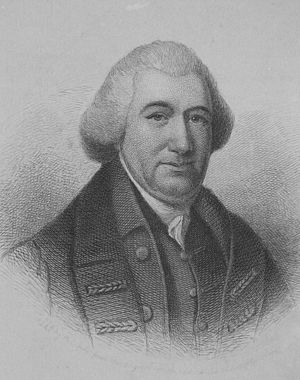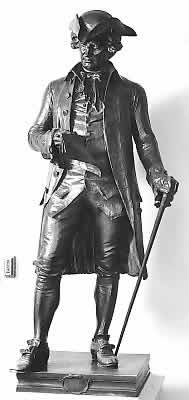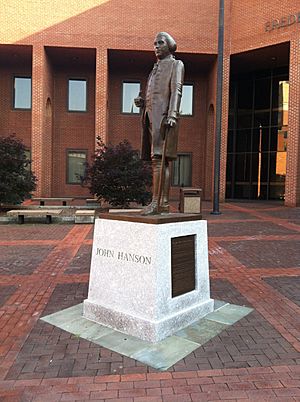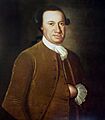John Hanson facts for kids
Quick facts for kids
John Hanson
|
|
|---|---|

Portrait of Hanson attributed to John Hesselius, c. late 1760s
|
|
| 1st President of the Confederation Congress | |
| In office November 5, 1781 – November 3, 1782 |
|
| Preceded by | Thomas McKean (as 8th President of the Continental Congress) |
| Succeeded by | Elias Boudinot |
| Personal details | |
| Born | April 14, 1721 near Port Tobacco, Province of Maryland |
| Died | November 15, 1783 (aged 62) Oxon Hill, Prince George's County, Maryland |
| Spouse | Jane Contee |
| Children | 8, including Alexander |
| Parents | Samuel Hanson Elizabeth Storey |
| Occupation | Merchant, politician |
| Signature | |
John Hanson (April 14, 1721 – November 15, 1783) was an important leader during the American Revolution. He was a Founding Father from Maryland. He worked as a merchant and politician.
In 1779, Hanson became a delegate to the Continental Congress. He had already helped the Patriot cause in Maryland in many ways. In 1781, he signed the Articles of Confederation. This happened after Maryland agreed to join the other states.
In November 1781, Hanson was chosen as the first President of the Confederation Congress. This was after the Articles of Confederation were officially approved. Because of this, some people have argued that he was actually the first President of the United States.
Contents
Early Life and Family
John Hanson was born on April 14, 1721, in Port Tobacco Parish, Maryland. He grew up on a large farm called "Mulberry Grove." His family was wealthy and well-known. His father, Samuel Hanson, owned a lot of land and was also a politician.
John Hanson's grandfather, also named John, came to Maryland around 1661. He worked as an indentured servant at first. For a long time, some people thought John Hanson was related to a Swedish family. However, later research showed this was not true.
We don't know much about Hanson's early life. Wealthy children like him usually had private teachers at home. He followed his father's path, becoming a farmer and a public official.
Political Career
Hanson started his public service in 1750. He was made sheriff of Charles County. In 1757, he was elected to the Maryland General Assembly. He served there for twelve years.
Maryland was a proprietary colony, meaning it was owned by a family. Hanson joined the "popular party." This group wanted to stop the governors from gaining too much power. He strongly opposed the Stamp Act in 1765. He also signed a resolution in 1769 to boycott British goods. This was to protest the Townshend Acts.

In 1769, Hanson moved to Frederick County. He held several jobs there, like deputy surveyor and county treasurer. When problems with Great Britain grew worse in 1774, Hanson became a leading Patriot in Frederick County. He led a meeting that opposed the Boston Port Act.
In 1775, he was a delegate to the Maryland Convention. This group met when the regular assembly was closed. He signed the Association of Freemen. This document hoped for peace but also called for fighting if Britain continued its harsh laws.
As the fighting began, Hanson led the Frederick County Committee of Observation. This group helped manage local government. Hanson was a great organizer. Frederick County sent the first southern troops to join George Washington's army. Hanson often used his own money to pay soldiers.
In June 1776, Hanson led a meeting that asked Maryland leaders to declare independence. While the Declaration of Independence was being written, Hanson was busy. He was making gun parts, storing gunpowder, and raising money and troops. He also dealt with people who supported Britain.
Hanson was elected to the Maryland House of Delegates in 1777. He served there for five years. In December 1779, he became a delegate to the Second Continental Congress in Philadelphia. He started serving in June 1780. Hanson was known for helping to fund the revolution in western Maryland. He joined several committees that dealt with money.
When Hanson joined Congress, Maryland was holding up the approval of the Articles of Confederation. Maryland did not have claims to western lands. It refused to approve the Articles until other states gave up their land claims. Once other states did this, Maryland approved the Articles in January 1781. Hanson and Daniel Carroll signed the Articles of Confederation for Maryland on March 1, 1781. With Maryland's approval, the Articles officially began.
In 1782, Hanson announced a day of "Solemn Thanksgiving" for the Continental Congress.
President of Congress

On November 5, 1781, Congress chose Hanson as its president. Under the Articles of Confederation, Congress held both law-making and executive power. The president's job was mostly ceremonial. However, Hanson had to lead discussions, handle official letters, and sign documents.
Hanson found the work tiring. He thought about quitting after only one week because of his poor health. But his colleagues asked him to stay. Congress did not have enough members to choose a new president. Hanson stayed out of duty. His term as a delegate was almost over, but Maryland re-elected him. So, Hanson continued to serve as president until November 4, 1782.
The Articles of Confederation said that presidents of Congress would serve one-year terms. Hanson was the first to complete a full one-year term. However, he was not the very first president to serve under the Articles. Samuel Huntington was president when the Articles began in March 1781. Then, Samuel Johnston was elected in July 1781, but he turned down the job. After that, Thomas McKean was elected. McKean served for a few months and resigned in October 1781. Hanson began his term after McKean. A special moment during Hanson's term was when George Washington presented Cornwallis's sword to Congress. This happened after the British surrendered at Yorktown.
Later Life and Family
After his one-year term as president, Hanson left public office. He was in poor health. He died on November 15, 1783, while visiting his nephew's farm in Prince George's County, Maryland. He was buried there.
Around 1744, John Hanson married Jane Contee. They had eight children. One of their sons, Peter Contee Hanson, died during the American Revolutionary War at the battle of Fort Washington. Another son, Alexander Contee Hanson Sr., became a well-known writer.
Legacy

In 1898, a descendant of Hanson, Douglas H. Thomas, wrote a book saying Hanson was the first true President of the United States. Thomas helped get Hanson chosen to represent Maryland in the National Statuary Hall Collection in Washington, D.C. In 1903, bronze statues of Hanson and Charles Carroll were placed there.
Some historians have questioned if Hanson was the best choice for this honor. However, historian Ralph Levering said Hanson "probably contributed as much as any other Marylander to the success of the American Revolution." Today, some Maryland lawmakers have thought about replacing Hanson's statue with one of Harriet Tubman.
The idea that Hanson was a forgotten first president was also promoted in a 1932 book. This book claimed Hanson was as important as George Washington. However, historians say these books were not based on deep research. Other historians point out that if anyone should be called the "first president," it might be Peyton Randolph or John Hancock.
In 1972, Hanson was shown on a 6-cent U.S. postal card. In 1981, he was on a 20-cent U.S. postage stamp. U.S. Route 50 between Washington D.C. and Annapolis is named the John Hanson Highway. There are also middle schools named after him in Maryland.
In the 1970s, a descendant of Hanson, John Hanson Briscoe, helped establish April 14 as John Hanson Day in Maryland. In 2009, the John Hanson Memorial Association was created. Its goal is to build a memorial and teach people about Hanson, including the myths about him.
Images for kids
See also
 In Spanish: John Hanson para niños
In Spanish: John Hanson para niños



